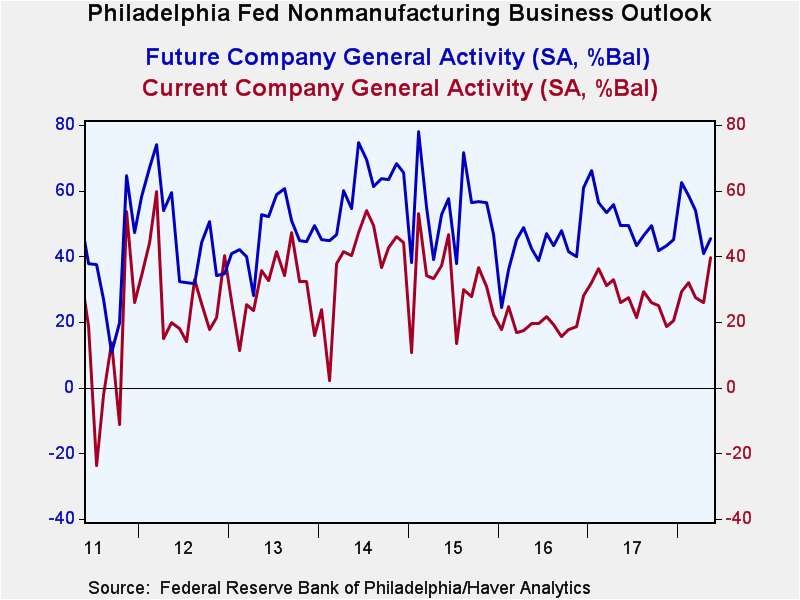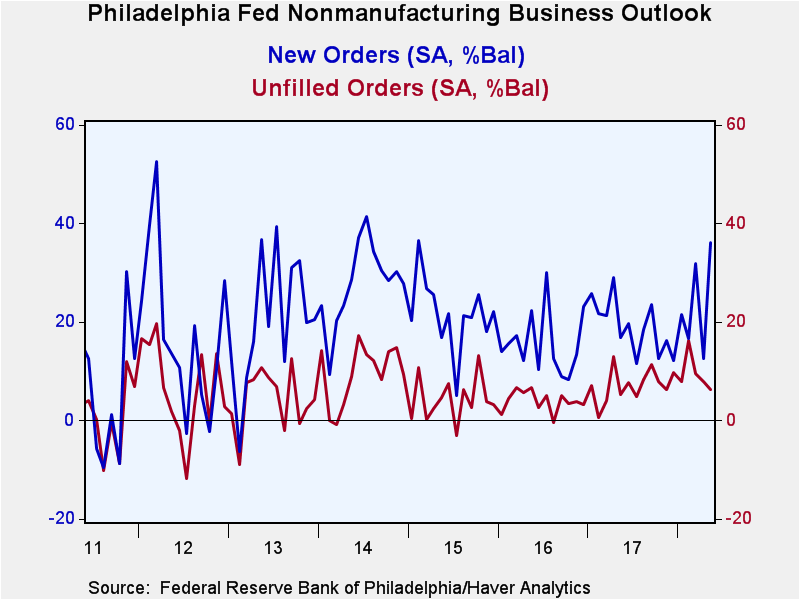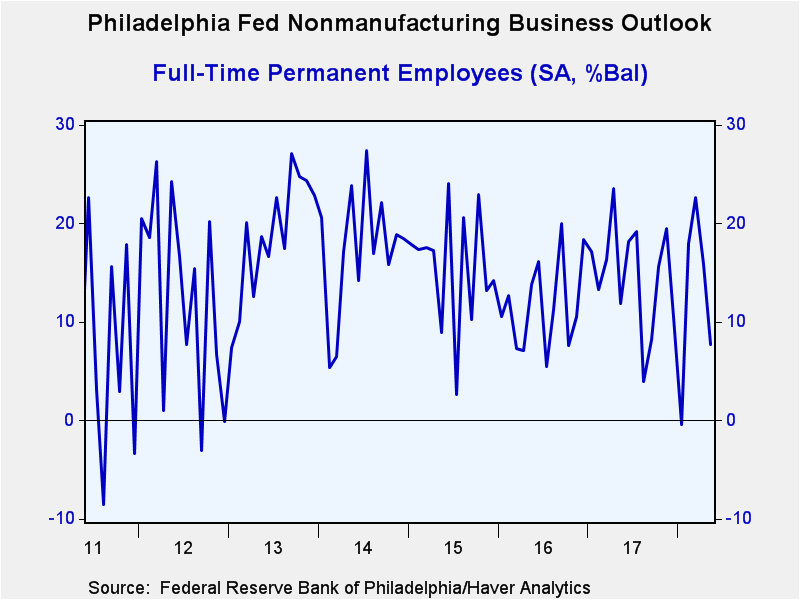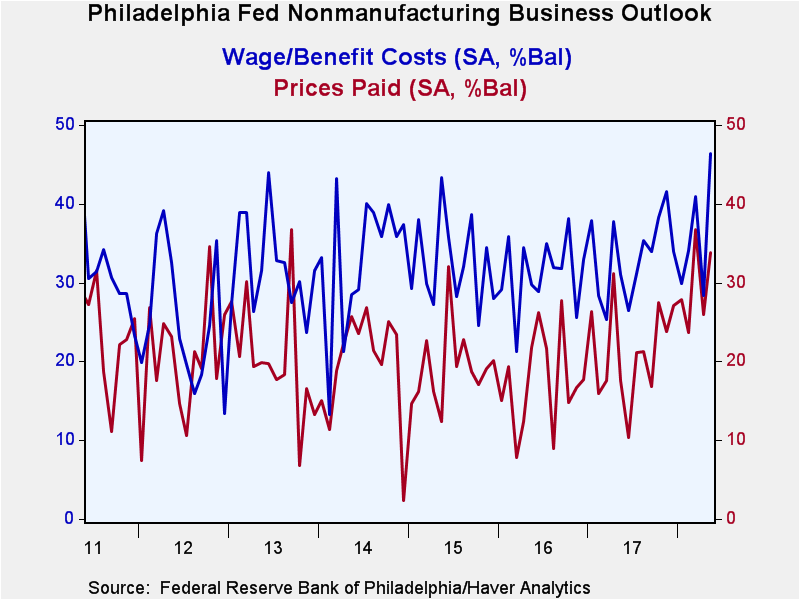 Global| May 22 2018
Global| May 22 2018Philadelphia Fed Nonmanufacturing Business Activity Strengthens to Four-Year High
by:Tom Moeller
|in:Economy in Brief
Summary
The Federal Reserve Bank of Philadelphia's Nonmanufacturing Business Index of current conditions at the company level increased to 39.5 in May as it improved to the highest level since 2015. Fifty-two percent of respondents reported [...]
The Federal Reserve Bank of Philadelphia's Nonmanufacturing Business Index of current conditions at the company level increased to 39.5 in May as it improved to the highest level since 2015. Fifty-two percent of respondents reported an increase in current activity while 12% reported a decline.
The expectations index at the company level for May rose to 45.3 from 40.8. It remained down sharply from 62.6 in January.
The new orders index jumped to the highest level since February 2015. The sales or revenue index similarly improved to the highest point since June of last year. The inventories series rebounded m/m and showed the quickest rate of accumulation since January 2017. Working the other way, the unfilled orders index declined to a twelve-month low.
On the labor front, the wages & benefits reading surged to a record high. The number of full-time permanent employees index declined, however, to the lowest level since January after showing strength during the last few months. The index of part-time/temporary employment strengthened m/m but was steady y/y. The average workweek reading increased following a sharp drop in April.
The index for capital spending on equipment and software surged to the highest level since March 2012. The capital expenditures for facilities index declined to the lowest point since November 2016.
The index of prices paid rebounded following a sharp April drop, and continued the upward trend in place since the middle of last year. An increased 34% of respondents paid higher prices while none paid less. The prices received index surged to the highest level since April of last year.
The Philadelphia Fed figures are diffusion indexes which are calculated by subtracting the percent of respondents reporting poorer business conditions from those reporting improvement. So, readings above zero indicate more positive than negative responses. These indexes have a good correlation with growth in the series covered. The data are available in Haver's SURVEYS database.
| Federal Reserve Bank of Philadelphia: Nonmanufacturing Business Outlook Survey (Diffusion Index, SA) | May | Apr | Mar | May'17 | 2017 | 2016 | 2015 |
|---|---|---|---|---|---|---|---|
| General Activity - Company | 39.5 | 26.0 | 27.6 | 26.0 | 27.3 | 19.7 | 31.3 |
| New Orders | 36.2 | 12.5 | 31.9 | 16.8 | 19.1 | 15.7 | 21.8 |
| Sales or Revenue | 33.7 | 13.5 | 24.0 | 26.2 | 27.9 | 16.2 | 23.8 |
| Inventories | 8.2 | 0.1 | 2.3 | 0.2 | 3.8 | 4.4 | 5.2 |
| Number of Full-Time Permanent Employees | 7.7 | 15.8 | 22.6 | 11.9 | 14.8 | 11.7 | 15.6 |
| Prices Paid | 33.8 | 26.0 | 36.7 | 17.6 | 21.4 | 17.5 | 19.3 |
| Wage & Benefit Costs | 46.4 | 28.3 | 40.9 | 31.0 | 33.4 | 31.2 | 32.5 |
| Expected General Activity - Company | 45.3 | 40.8 | 54.1 | 49.4 | 49.9 | 43.0 | 53.8 |
Tom Moeller
AuthorMore in Author Profile »Prior to joining Haver Analytics in 2000, Mr. Moeller worked as the Economist at Chancellor Capital Management from 1985 to 1999. There, he developed comprehensive economic forecasts and interpreted economic data for equity and fixed income portfolio managers. Also at Chancellor, Mr. Moeller worked as an equity analyst and was responsible for researching and rating companies in the economically sensitive automobile and housing industries for investment in Chancellor’s equity portfolio. Prior to joining Chancellor, Mr. Moeller was an Economist at Citibank from 1979 to 1984. He also analyzed pricing behavior in the metals industry for the Council on Wage and Price Stability in Washington, D.C. In 1999, Mr. Moeller received the award for most accurate forecast from the Forecasters' Club of New York. From 1990 to 1992 he was President of the New York Association for Business Economists. Mr. Moeller earned an M.B.A. in Finance from Fordham University, where he graduated in 1987. He holds a Bachelor of Arts in Economics from George Washington University.










